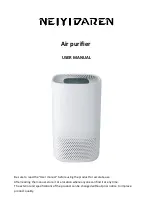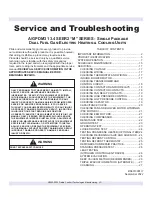
RT-SVX34F-EN
89
Sequence of Operation
Mechanical Cooling Sequence
Of Operation
Time delays are built into the controls to increase
reliability and performance by protecting the compressors
and maximizing unit efficiency.
Units Without an Economizer
For 27.5 to 35 Ton units, when mechanical cooling is
required, the RTRM energizes the Compressor Contactor
(CC1) coil. When the CC1 contacts close, the Compressor
CPR1 and Outdoor Fan Motor (ODM1) will start providing
the 3 minute “off” time has elapsed. ODM2 and ODM3
cycles off/on based on the outdoor ambient temperature
as measured by the Outdoor Air Sensor (OAS). CPR1
cycles off as required providing the 3 minute “on” time has
elapsed.
With CPR1 operating for a minimum of 3 minutes. If
additional cooling is required, the RTRM energizes the 2nd
compressor contactor (CC2) to bring on CPR2. While CPR1
continues to run, CPR2 cycles on/off as needed to meet the
cooling requirements.
For 40 Ton constant volume and variable air volume
applications, once CPR1 has operated for a minimum of 3
minutes, and additional cooling is required, the RTRM
cycles CPR1 off and energizes compressor contactor CC2.
If additional cooling is required, the RTRM energizes
compressor contactor (CC1) providing CPR1 has been off
for a minimum of 3 minutes. This configuration will allow
the dual circuit unit to operate with three steps of cooling
if CPR1 is the lead compressor.
For 50 Ton constant volume and variable air volume
applications, once CPR1 has operated for a minimum of 3
minutes, and additional cooling is required, the RTRM
cycles CPR1 off and energizes compressor contactors CC2
and CC3 simultaneously. If additional cooling is required,
the RTRM energizes compressor contactor (CC1)
providing CPR1 has been off for a minimum of 3 minutes.
This configuration allow the dual circuit unit to operate
with three steps of cooling if CPR1 is the lead compressor.
If the indoor Fan selection switch is set to the “AUTO”
position on constant volume applications, the RTRM
energizes the Indoor Fan Contactor (F) coil approximately
one second after energizing first stage compressor
contactor (CC1). When the cooling cycle is complete and
CC1 is de-energized, the RTRM keeps the Fan on for
approximately 60 seconds to enhance unit efficiency. On
variable air volume applications, the Fan operates
continuously.
Economizer Operation Based on Dry Bulb
Standard economizer dry bulb change over has five field
selectable temperatures 55, 63, 67, 70, 73°F. Refer to
Table 25, p. 49
for the proper potentiometer setting for
each temperature selection.
The economizer option allows cooling utilizing outdoor air
when the temperature is below the specified dry bulb
setpoint (73° ±2°F factory setting). The air is drawn into the
unit through modulating dampers. The ECA modulates
the economizer dampers from minimum position to full
open based on a 1.5°F control point below either the space
temperature setpoint for constant volume applications or
1.5°F around the supply air temperature setpoint for
variable air volume applications.
If the Mixed Supply Air Sensor (MAS) senses that supply
air temperature is too cold, the dampers are held in their
current position until the supply air temperature rises, or
begin to modulate toward the minimum position if the
supply air temperature continues to drop.
The economizer control allows fully integrated cooling
operation between the compressor(s) and the economizer
when needed to satisfy the cooling setpoint. The RTRM
will not allow a compressor to operate until the
economizer dampers have been fully open for at least
three minutes. The RTRM evaluates the rate of
temperature change during this delay and will energize
compressor(s) as needed to maintain temperatures within
setpoint deadbands.
If a power exhaust option is installed:
1.
The power exhaust fan(s) comes on based on the
position of the of the exhaust fan setpoint
potentiometer on the RTOM (Reliatel Options Module).
The setpoint is factory set at 25%. The exhaust fan(s)
will come on anytime the economizer damper position
is equal to or greater than the exhaust fan setpoint.
2. Physical damper blade “stops” that limit the amount of
exhaust airflow by limiting the maximum opening of
the damper blades. These stops (sliding brackets
secured with wing-nuts) are present under the rain
hood on the non-modulating power exhaust option.
There is one stop on each side of each damper. The
practical range of blade position control is between
1.5" and 4.0" blade opening. The damper is wide-open
at 4.0". The stops on each side of a damper must be in
the same position, such that the damper blade
connecting member contacts the stops at the same
time.
3. The modulating power exhaust actuator is a slave to
the position of the economizer damper actuator such
that the power exhaust dampers proportionally follow
or track the fresh air damper position. The proportional
offset between the dampers is adjusted under the rain
hood by hole position selection of the power exhaust
actuator jack shaft on the damper linkage arm.
4. When the Statitrac™ option is selected, the Exhaust
Blade Actuator will modulate independently to the
economizer in order the relieve positive building
















































